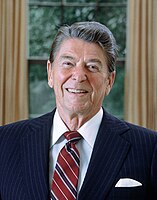| ||||||||||||||||||||||||||
| ||||||||||||||||||||||||||
 County Results
Reagan 40–50% 50–60% 60–70% 70–80% 80–90%
| ||||||||||||||||||||||||||
| ||||||||||||||||||||||||||
| Elections in Utah |
|---|
 |
The 1984 United States presidential election in Utah took place on November 6, 1984. All 50 states and the District of Columbia, were part of the 1984 United States presidential election. State voters chose five electors to the Electoral College, which selected the president and vice president of the United States. Utah was won by incumbent United States President Ronald Reagan of California, who was running against former Vice President Walter Mondale of Minnesota. Reagan ran for a second time with incumbent Vice President and former C.I.A. Director George H. W. Bush of Texas, and Mondale ran with Representative Geraldine Ferraro of New York, the first major female candidate for the vice presidency.
The presidential election of 1984 was a very partisan election for Utah, with just over 99% of the electorate voting for either the Democratic or Republican parties,[1] though several other parties appeared on the ballot. Reagan posted the highest vote share of any nominee in the state since William Jennings Bryan in 1896, and carried every county in the state. Reagan's best county was Box Elder County, although he broke 80% in 15 counties. Mondale's best county was Carbon County, the only one in which he managed to hold Reagan to a plurality, rather than a majority win. Mondale did make gains vis-à-vis Jimmy Carter of over ten percent in eastern Daggett County and San Juan County, probably related to a general trend in this election of Native American voters towards Mondale.[2] The highly populated Salt Lake County contributed about half of the Democratic votes produced by Utah, but still was won decisively by Reagan by 40 points, in what was, overall, a very solid statewide victory.
Reagan won a resounding 50-point landslide victory in Utah, his strongest victory in the nation both by vote share and by margin. For the third election in a row, Utah gave the Republican nominee his highest vote share in the nation, a trend that began in 1976[3] and would continue through 1988, and intermittently through 2012. Reagan's strength in Utah was part of a broader phenomenon of the growing importance of the Mountain West as a Republican base; this region had been a swing region for the sixty years following James Weaver's Populist run in 1892, solidly backing William Jennings Bryan in his narrow 1896 defeat as well as Woodrow Wilson and Harry Truman in their narrow 1916 and 1948 wins, respectively. The Mountain West began trending Republican in close elections in 1960, however, when Nixon carried all but two states in the region (New Mexico and Nevada). Jimmy Carter's presidency accelerated the trend, with his administration's policies on water and energy being widely perceived as a 'war on the West’.[4] In 1980, Carter underperformed even his low national percentage throughout the West.[5] Reagan's popularity in the West increased in 1984,[6] no Republican nominee has received such strong support in the Mountain West as Reagan did.
Enid Greene Mickelsen and Jon Huntsman Jr. were co-directors of Reagan's campaign in the state.[7]
David D. Flowers, at age 18, was the youngest presidential elector in history according to the Congressional Research Service. Fowers threatened to vote for Lyndon LaRouche as a faithless elector to protest the electoral college, but chose not to. The other electors were Charles W. Akerlow, Douglas Bischoff, Cathy Arentz, and William A. Stevenson.[8][9]
- ^ "Dave Leip's Atlas of U.S. Presidential Elections". Uselectionatlas.org. Retrieved November 11, 2013.
- ^ Menendez, Albert J.; The Geography of Presidential Elections in the United States, 1868-2004, p. 109 ISBN 0786422173
- ^ Menendez; The Geography of Presidential Elections in the United States, pp. 104, 110, 112, 115, 119, 124, 130
- ^ Cannon, Lou (January 9, 1978). "Vice President Embarks on Mission to Mend Western Fences". Washington Post. ISSN 0190-8286. Retrieved December 31, 2020.
- ^ "CQ Almanac Online Edition". library.cqpress.com. Retrieved December 31, 2020.
- ^ Ed Quillen (October 13, 1997). "The Mountain West: A Republican Fabrication". www.hcn.org. Retrieved December 31, 2020.
- ^ "Students work in trenches of Utah's political arena". The Daily Utah Chronicle. January 27, 1984. p. 1. Archived from the original on June 13, 2024 – via Newspapers.com.
- ^ "Utah Elector Ends Protest Of System". The Herald-Sun. December 16, 1984. p. 6B. Archived from the original on June 13, 2024 – via Newspapers.com.
- ^ "Utah's electors make it official". The Spectrum. December 18, 1984. p. 4. Archived from the original on June 13, 2024 – via Newspapers.com.


